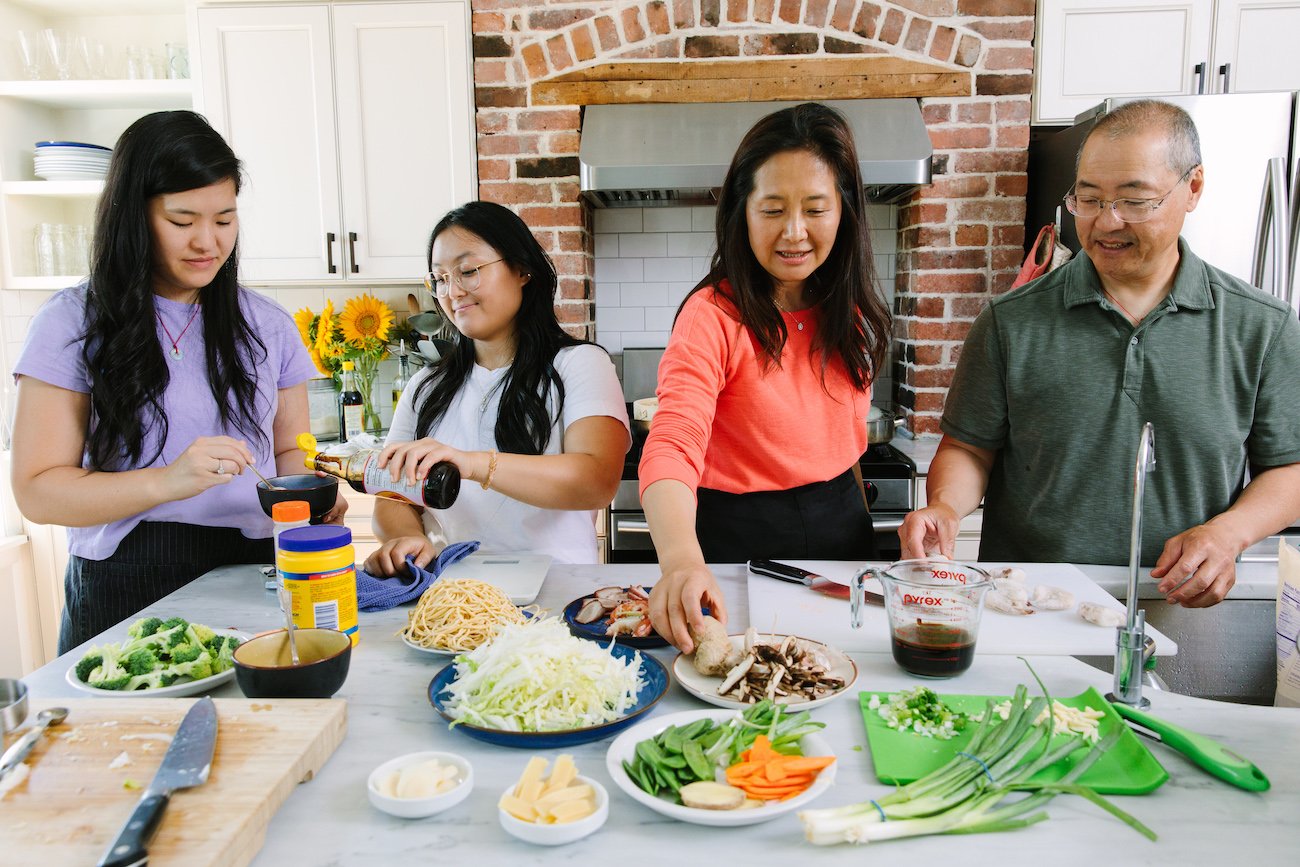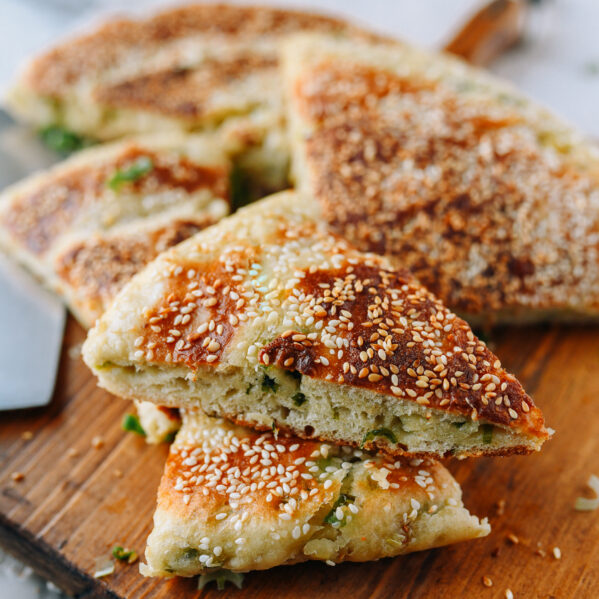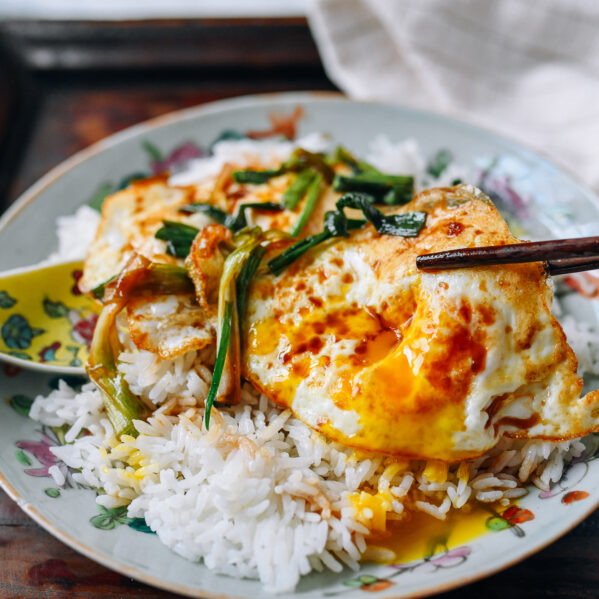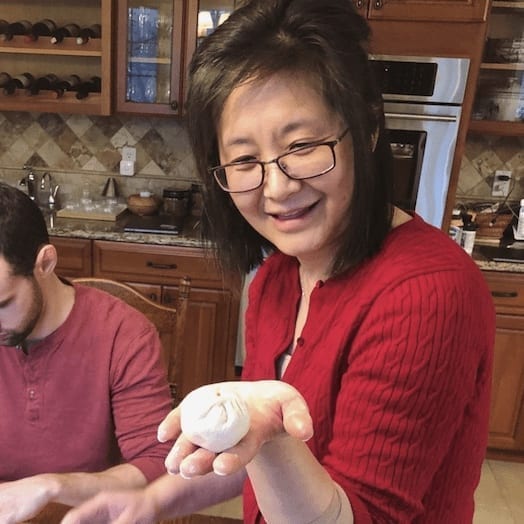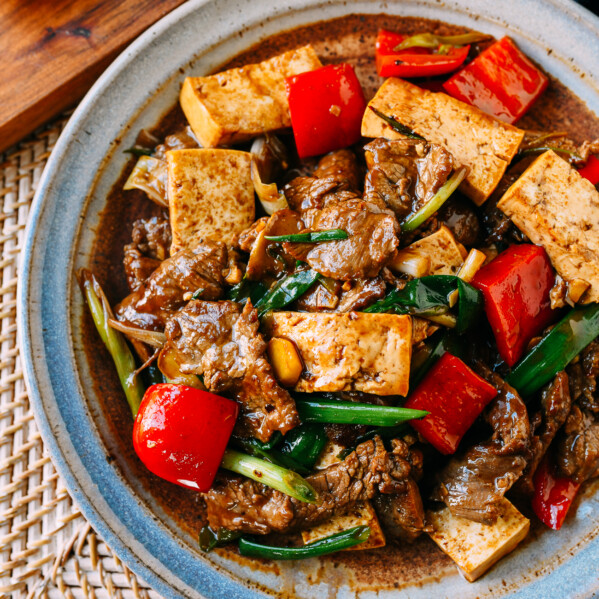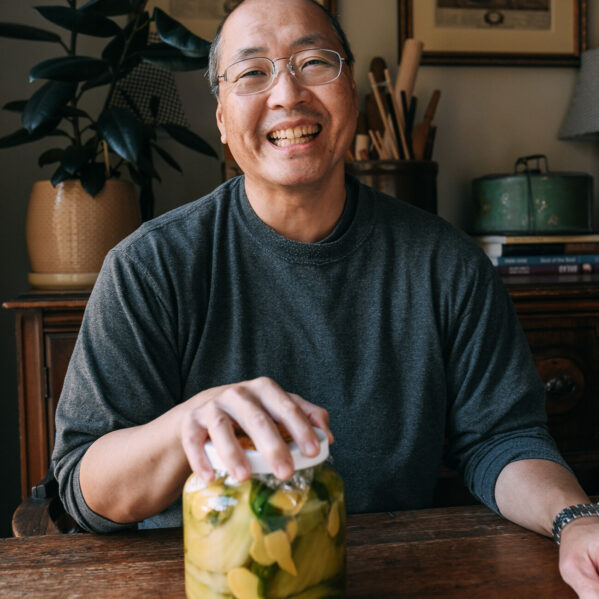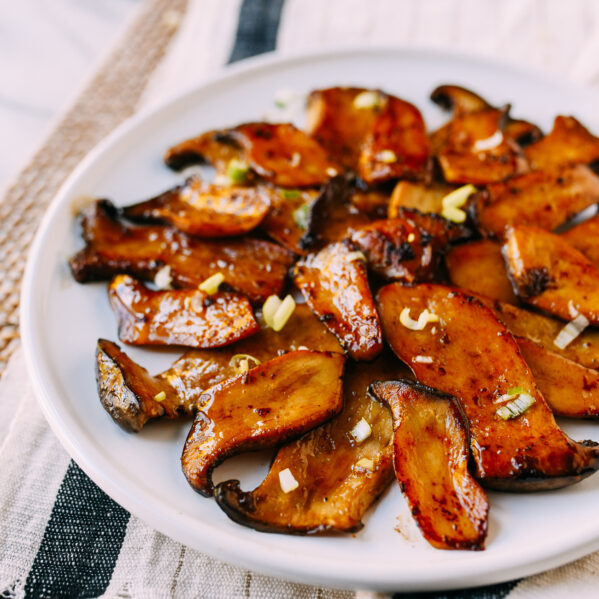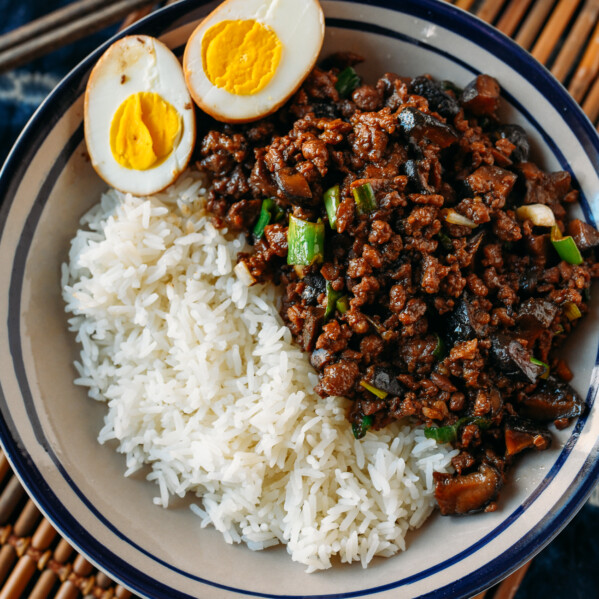
Our Singapore Noodles recipe tastes just like what you’d get at any Chinese takeout or Cantonese restaurant. We hope you give it a try and enjoy this iconic dish!
This updated version of our original Singapore mei fun recipe (published 11/4/13) includes more detailed instructions as well as recipe improvements and a video—be sure to check it out after the step-by-step photos!
Note:
If you’re not into curry, check out our Xiamen Chow Mei Fun recipe. It’s a similar dish without the curry powder! If you’re looking for a vegan/vegetarian version of this dish, check out our Vegetarian Singapore Noodles recipe.
A dish you won’t find in singapore
One of the most popular dishes on any Chinese take-out menu is Singapore Noodles, or Singapore Mei Fun, sometimes spelled Singapore Mai Fun. It’s certainly a must-order for our family anytime we order Chinese takeout.
Now, we’ve met people from Singapore who are pretty bewildered when they come to the U.S. and see their country’s moniker attached to this dish of noodles and curry powder.
Singapore Noodles actually have less to do with Singapore, and more with Hong Kong, where it was invented. You’ll still find it not just in Chinese takeout joints, but Cantonese restaurants, because Cantonese chefs invented it!
Curry powder arrived in Hong Kong by way of British colonists. (Did you know that curry powder is not a spice, but actually a spice mix? It consists of turmeric (to which it owes its vibrant yellow color), coriander, cumin, cinnamon, ginger, and other spices, and was created as a shorthand attempt at building the complex flavors of the Indian curries British colonialists had developed a taste for.
So when curry powder arrived in Hong Kong by way of the British, dishes like Hong Kong Beef Curry (check out Judy’s version and Sarah’s Instant Pot version), Dim Sum Curry Puffs, and Singapore Noodles were born.
That said, I’m still a bit fuzzy on where the Singaporean connection comes in. Perhaps it was named Singapore Mei Fun because Singapore has a significant Indian population? I’m not entirely sure what makes it Singaporean, just like I’m not sure what makes an egg roll Chinese!
Anyway, it was through Cantonese chefs that the dish made its way to Chinese American takeout restaurants and Cantonese restaurant menus across the United States. And as with many items on a takeout menu, it is delicious despite its fuzzy origins.
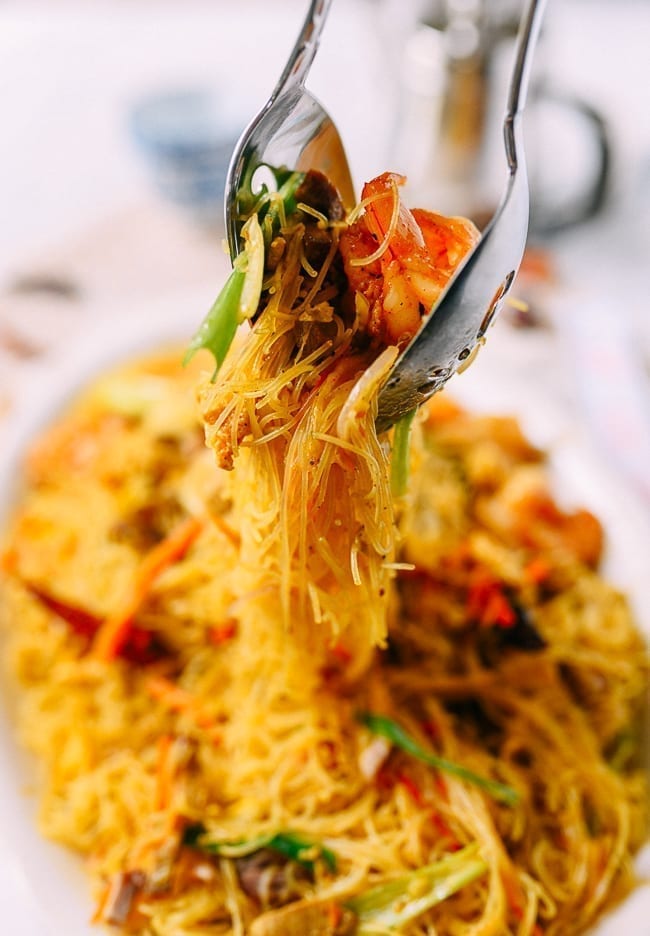
Singapore Mei Fun Ingredients
The ingredients for singapore noodles (curry powder, rice noodles, ham, napa cabbage, etc.) aren’t as difficult to find in grocery stores these days. If you have a Chinese market near you, even better!
But actually, almost all the ingredients in the recipe might be available at a well-stocked regular supermarket! We’re regularly seeing rice vermicelli noodles in the Asian/Ethnic aisle of the grocery store, and curry powder is standard in spice aisles these days. Even napa cabbage is showing up in produce sections! That said, you could also substitute savoy or green cabbage.
As for the Shaoxing wine, you can substitute a dry cooking sherry.
Gluten-free?
You only need to make two adjustments to the recipe: substitute dry cooking sherry for the Shaoxing wine, and use a GF soy sauce!
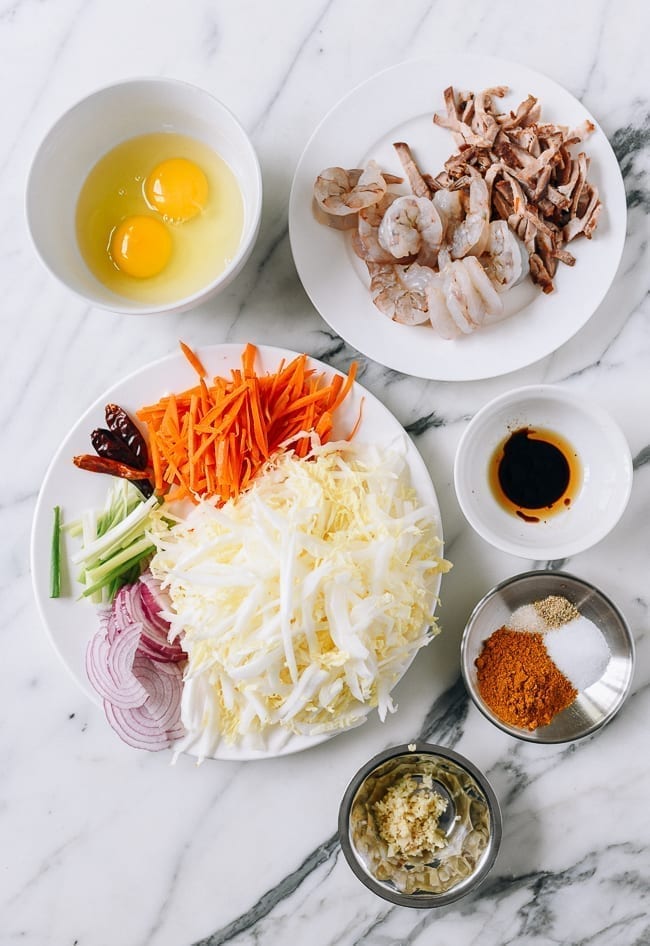
Is Chinese BBQ Pork, Ham or Chinese Sausage Traditional?
The protein you decide to use will depend on personal preference, availability, and perhaps what the chef’s preference is as the restaurant you frequent.
We find that most restaurants use julienned Chinese BBQ pork, char siu. These restaurants usually also offer roast pork on their menu. If you’re like many of our readers who’ve already tried our char siu recipe and keep some in the freezer for uses like this, you’re already set!
Thick-sliced Virginia ham from the deli counter is also a good choice, since it’s super convenient. You seldom see it in restaurant versions, however.
Lastly, you could use Chinese sausage. It’s not as common, but if you have it on hand and enjoy it, go for it! When we photographed this recipe, we used char siu, and we used ham when we filmed the video.
What Vegetables Are Used for Singapore Noodles?
Common vegetables in Singapore Noodles include carrots, napa cabbage or regular cabbage, onions, and scallions. Some versions have very few vegetables, if any.
We went a traditional route with this recipe, but you can change it up and add other veggies like celery, bean sprouts, mushrooms, red bell peppers (any bell pepper really), or anything else in the fridge. If you want the familiar dish you get from restaurants, though, stick to our ingredients.
Just make sure you take the time to julienne the napa cabbage, carrot, and scallions, and to thinly slice the red onion.
All the vegetables should be cut into approximately the same shape. This is a noodle dish, so everything (except the shrimp of course) must be in thin strips to match the shape of the noodles.
How To Prepare Dried Rice Noodles
The type of rice noodles you use for this Singapore Noodles recipe is very important!
You must use thin vermicelli rice noodles. Make sure they’re not mung bean vermicelli, which are clear, while the rice noodles are more opaque.
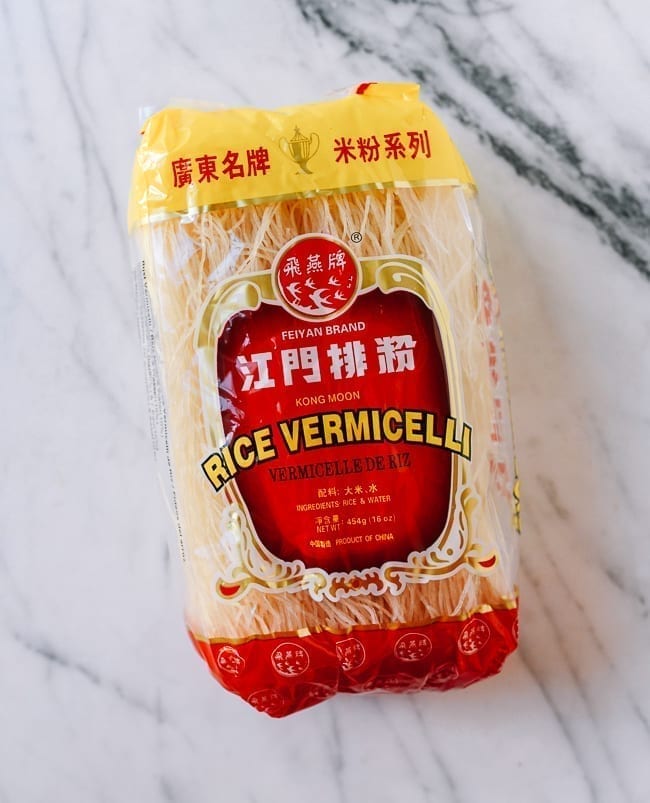
Depending upon brand of rice noodles you buy, soaking times may vary. However, how you soak the noodles makes a huge difference in the dish:
- Cold Overnight Soak: Soaking dried rice noodles in cold water overnight allows them to rehydrate gradually and will yield a softer texture in the finished dish. This is the preferred method, if you can remember to do it!
- 30 Minute Hot Water Soak: Soaking the noodles in hot tap water for at least 30 minutes also does the job, but the noodles may end up a bit more “al dente” in the finished dish.
- Boiling: You can also cook the noodles in boiling water for about 1 minute, but pay attention to package directions before deciding whether to use this method, as it’s easy to overcook them.
After you make these noodles once, you can make adjustments for the next time, including exploring other brands of dried rice vermicelli.
Singapore Noodles: Recipe Instructions
As with any stir-fry, make sure you have all your ingredients prepared before you start.
Prepare the noodles & shrimp:
Rehydrate the rice noodles either by soaking in cold water overnight, soaking in hot water for at least 30 minutes, or boiling for 1 minute (check package instructions before boiling).
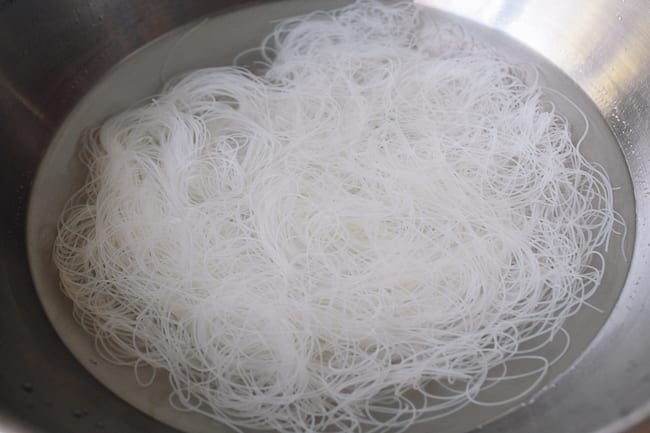
Drain the noodles in a colander just before you’re ready to cook. It’s ok if the noodles aren’t completely dry. Use kitchen shears to cut the long strands into 8-10 inch lengths, so they are easier to stir-fry and eat.
On to the shrimp. We call for a dozen large shrimp in this recipe. You can also use a larger quantity of smaller shrimp if you like, as long as it’s about 6-8 ounces/170-225g. Peel the shrimp, butterfly them from the back, and de-vein. Rinse and pat dry before cooking.
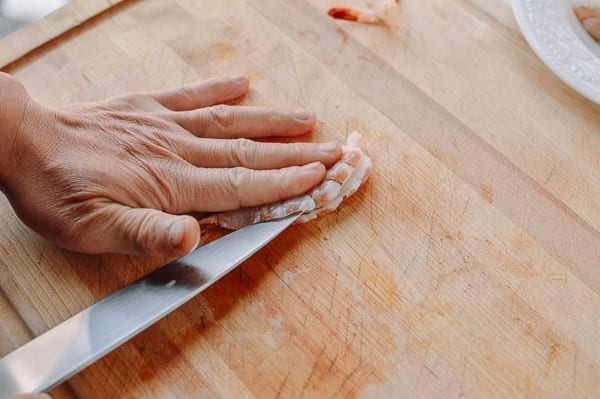
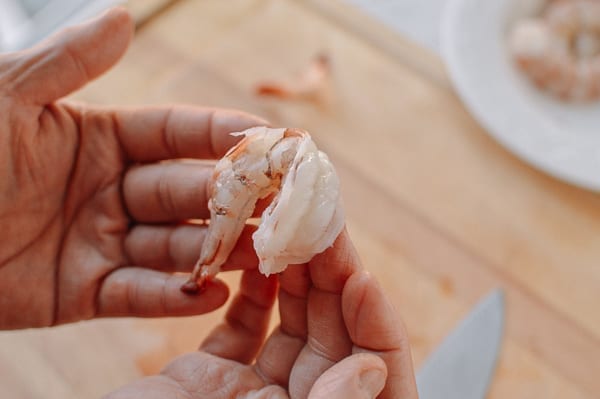
Restaurants generally use the smaller shrimp, but since you’re cooking at home, you can choose the size you want!
For this recipe, there’s no need to marinate or velvet them, but we have a whole article where you can learn more about how to size, buy and prepare to prepare shrimp for Chinese cooking.
Scramble the eggs:
Scrambled eggs are a traditional ingredient in Singapore Noodles. When it comes to noodle stir-fries or fried rice, you may have seen cooks or street vendors push other ingredients aside during the stir-fry process to add additional oil and scramble a few eggs. Once scrambled, they get mixed into the finished dish.
You can do that, but since there’s already a lot going on in the wok with this recipe, we recommend pre-scrambling the eggs. We’re doing everything in the wok, but you can also scramble your eggs in a separate pan or skillet.
Heat your wok over medium heat, and add 1 tablespoon of oil. Add the eggs.
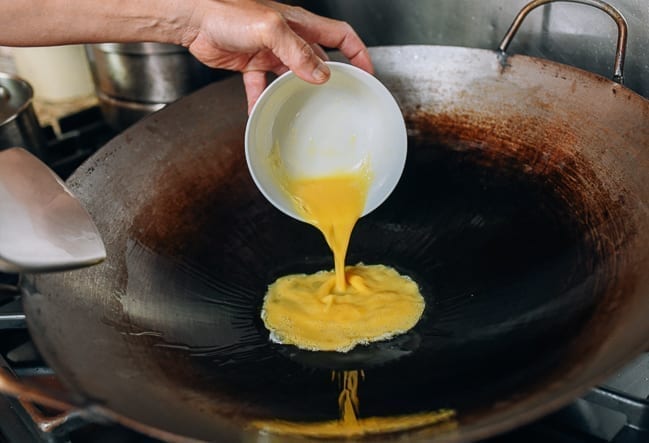
When they’ve cooked and bubbled along the sides…
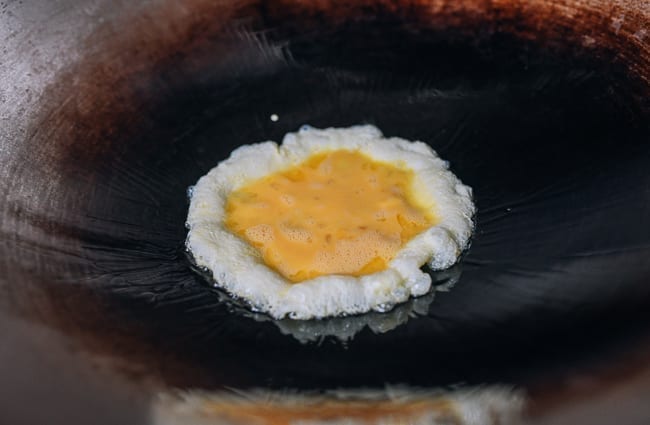
Flip them over, and break the egg up into rough strips with your wok spatula.
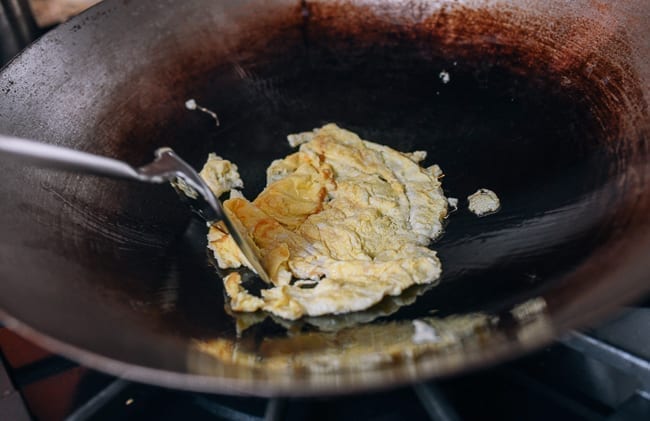
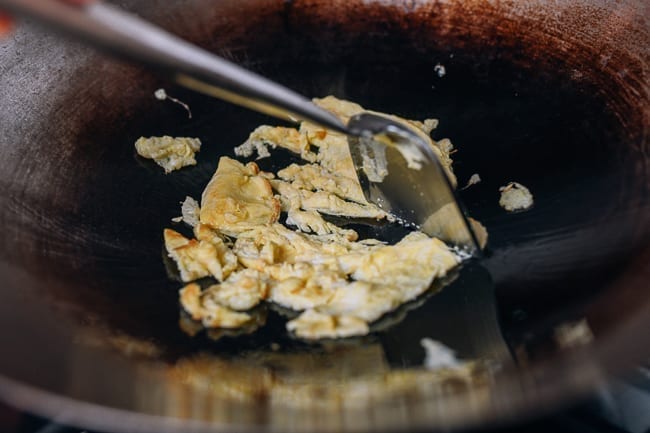
Remove from the wok and set aside.
Put it all together:
Heat your wok over medium heat. Add 1 ½ tablespoons of oil and the garlic.
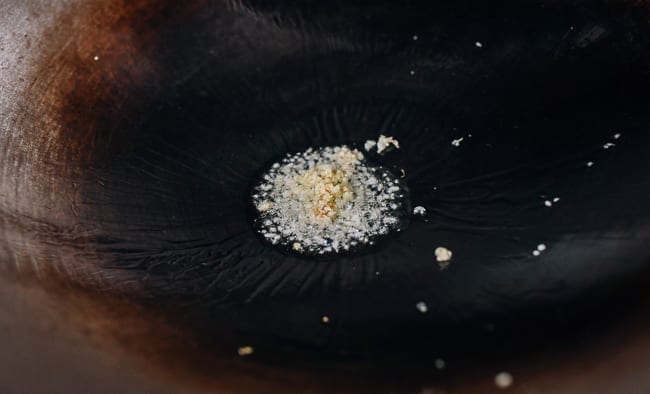
Cook for 15 seconds, and add the shrimp and roast pork (or ham or Chinese Sausage). Stir-fry for another 15 seconds.
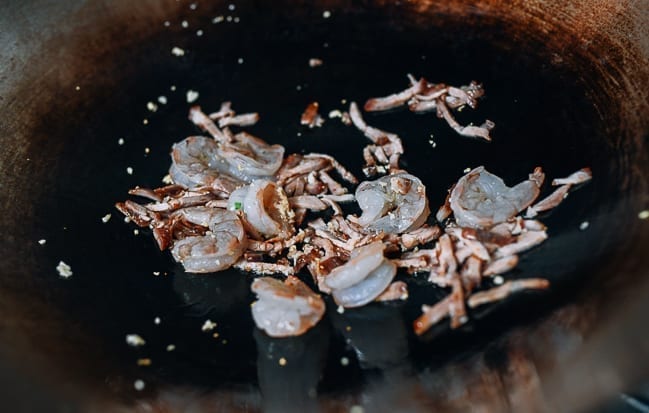
Add the Shaoxing wine around the perimeter of the wok and stir-fry for another 15 seconds.
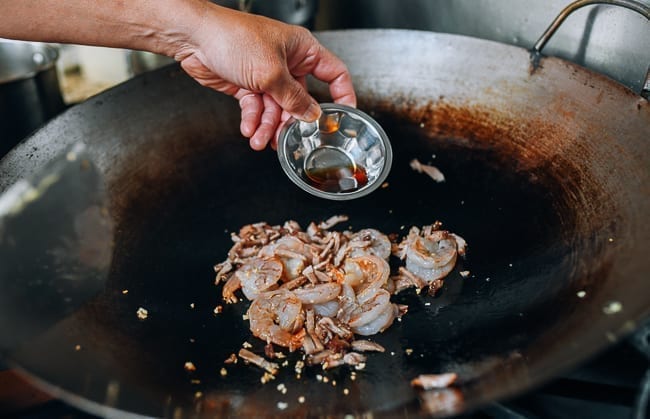
Then add the dried red chili peppers, napa cabbage, and carrots.
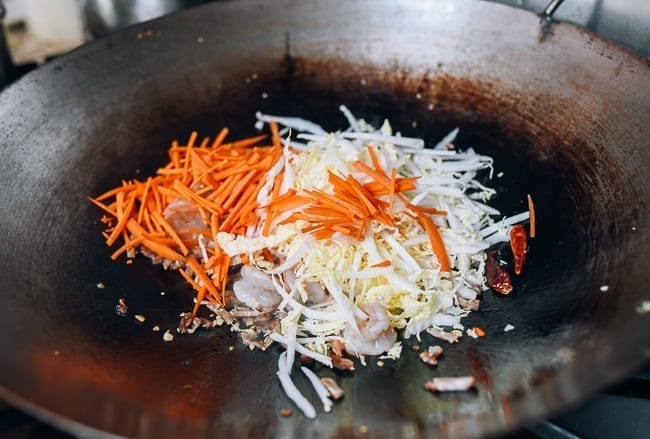
Stir-fry for 30 seconds.
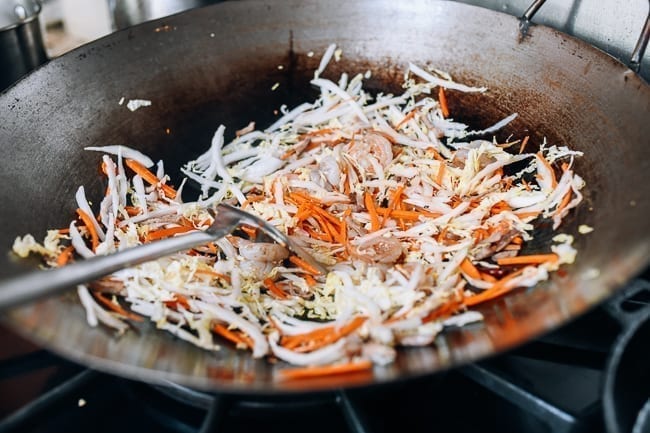
Now add the rice noodles.

Stir-fry for 1 minute, lifting and tossing the rice noodles with your spatula to loosen them.
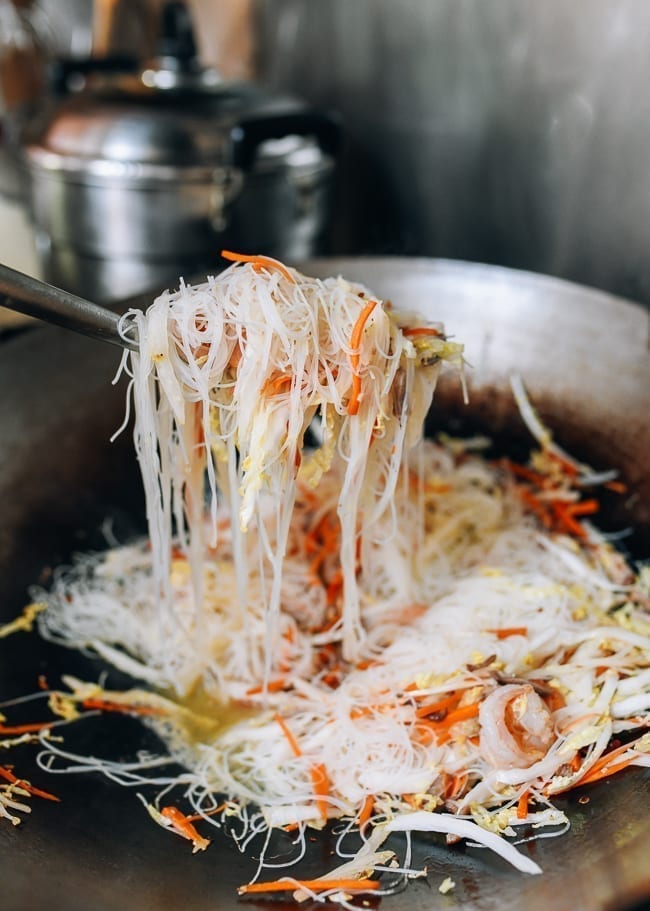
Next, sprinkle the curry powder, salt, sugar and white pepper evenly over the noodles. It’s best to measure these out in a pinch bowl before starting the dish. The amount of curry powder we use for this recipe is what our family likes but do use more or less according to your own personal taste and preference.
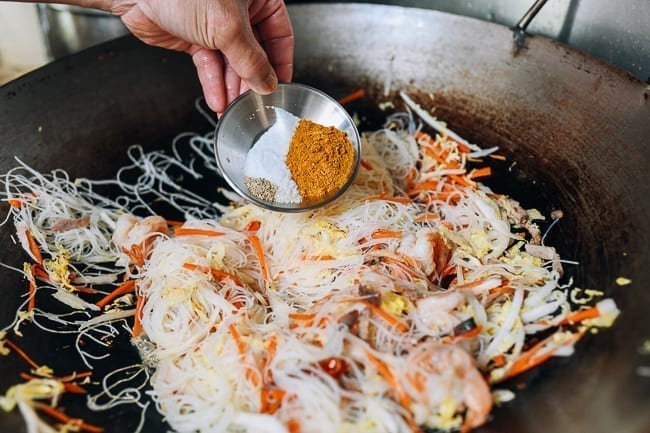
Stir-fry using a scooping and lifting motion to loosen the noodles and uniformly combine them with the spices, vegetables and meat. Start on one side of the wok and work your way around, making sure to firmly scrape the bottom of the wok with your spatula to prevent sticking. A hot wok is a must! You’ll see the curry color gradually coat everything to create a uniform color. It takes about 2 minutes to combine and warm everything through.
At this time, you can add some chicken stock or water if the noodles seem a bit dry. Use your own discretion on how much to add, because it depends on how hot your wok is and how much moisture was in your re-hydrated noodles and vegetables. Err on the side of more moisture, because they will not be as tasty if they have excessively dried out in the wok.
Add the sesame oil and soy sauce…
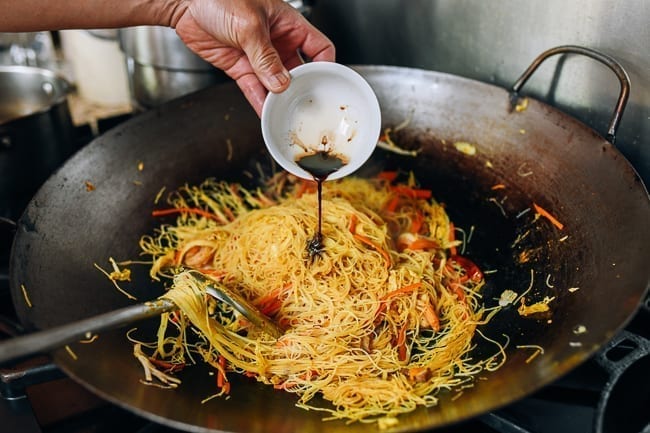
And the cooked egg.
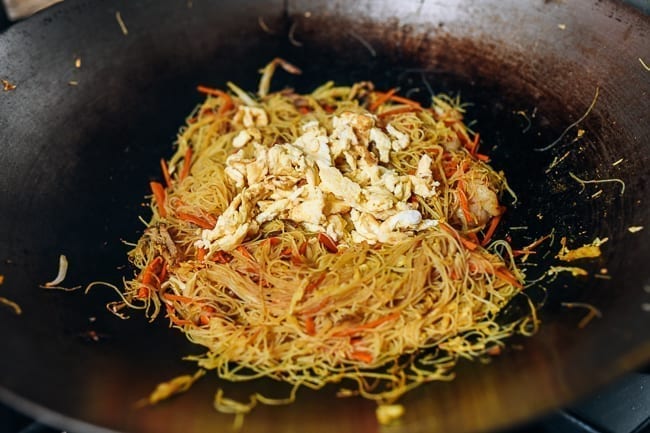
Mix thoroughly again for another minute until everything is combined and heated through—you should see more steam rising.
Next, add the scallions and red onion, and continue to stir-fry for another 20 seconds.
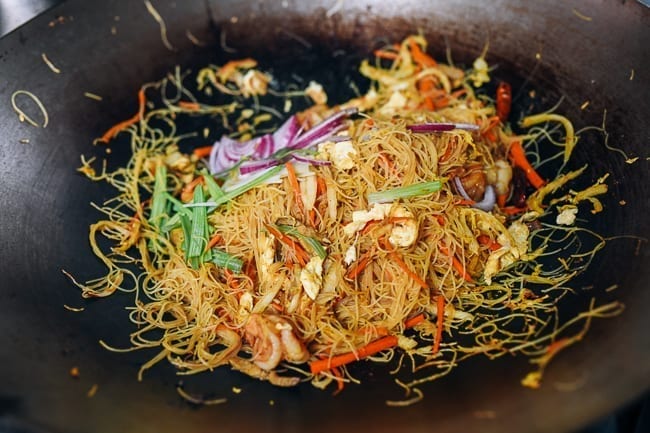
Some restaurants barely cook the scallion and the onion so they still have the fresh raw taste to complement the curry.
Alternatively, you can stir-fry the noodles longer until the scallions and onions are cooked through to your preference.
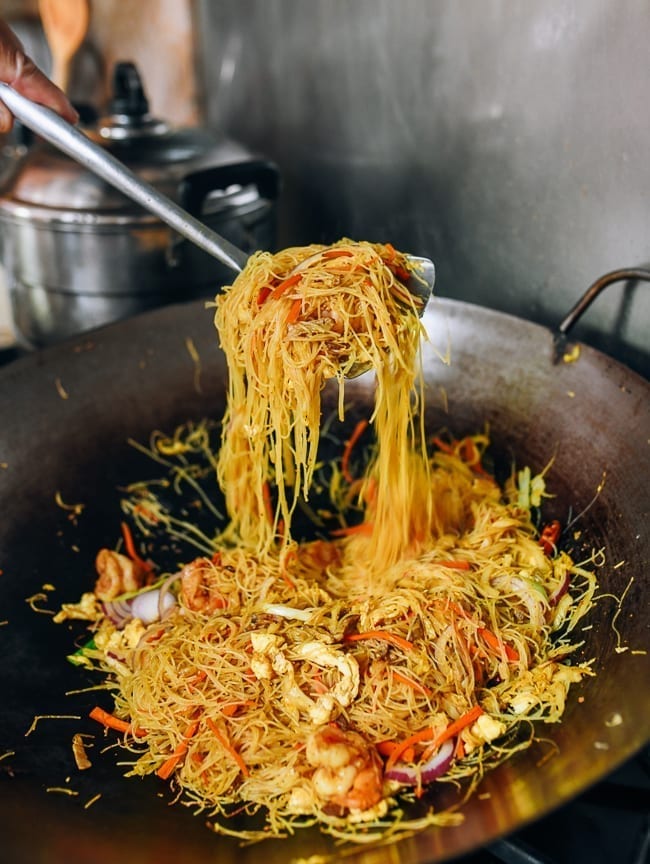
Plate and serve! Hot chili oil on the side is encouraged!
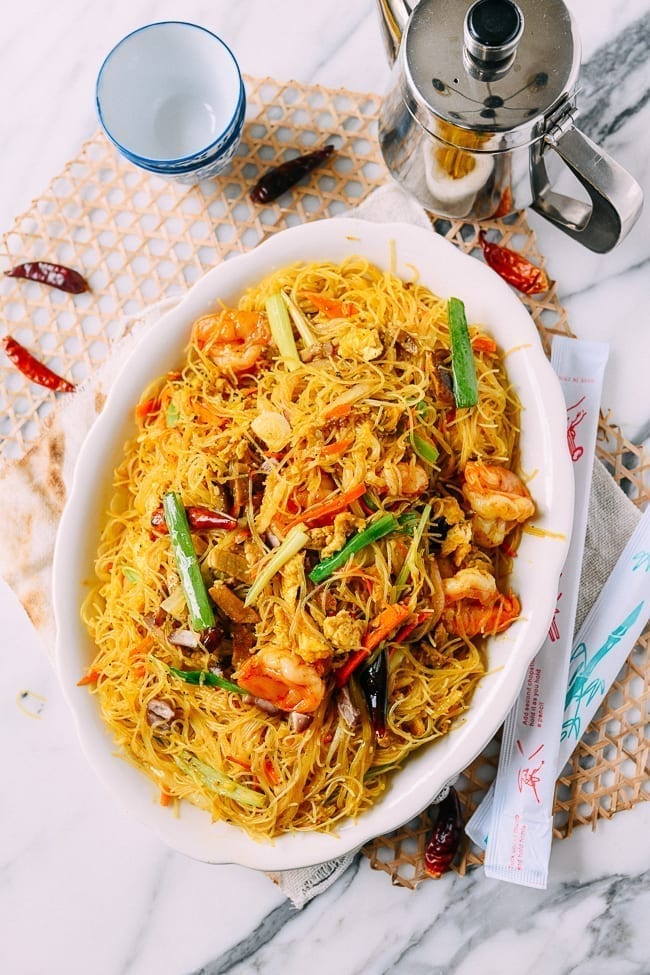
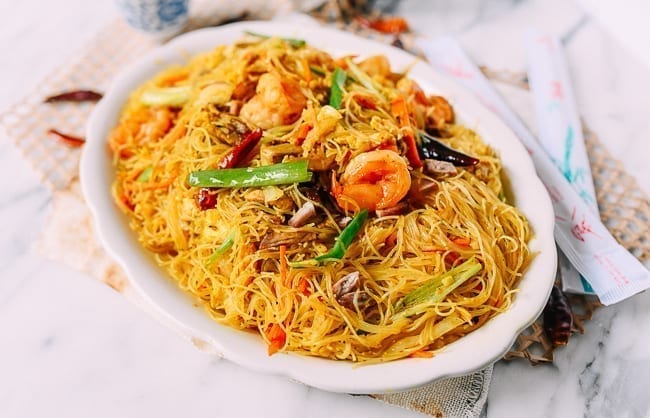
Watch Video!
Looking for more authentic recipes? Subscribe to our email list and be sure to follow us on Pinterest, Facebook, Instagram, and Youtube!
Recipe
Singapore Noodles (Singapore Mei Fun)
Ingredients
- 5 ounces dried vermicelli rice noodles
- 12 large frozen shrimp (peeled, deveined, and butterflied)
- 2 1/2 tablespoons vegetable oil (divided)
- 2 eggs (beaten)
- 2 cloves garlic (chopped)
- 4 ounces char siu (Chinese Roast Pork) (can substitute Virginia ham or Chinese Sausage/traditional sweet Lop Cheung)
- 3 dried red chili peppers
- 9 ounces napa cabbage (shredded, about 3 cups)
- 1 medium carrot (about 2.5 ounces/70g)
- 1 tablespoon Shaoxing wine (can substitute dry cooking sherry)
- 2 tablespoons curry powder or to taste
- 1 teaspoon salt or to taste
- 1/4 teaspoon sugar
- 1/8 teaspoon white pepper
- 2-4 tablespoons chicken stock or water (optional)
- ½ teaspoon sesame oil
- 1 ½ teaspoons soy sauce (can substitute GF soy sauce to make this gluten-free)
- 1 scallion (julienned)
- ½ of a red onion (about 2.5 ounces/70g, thinly sliced)
Instructions
Prepare the noodles, shrimp, and eggs:
- Rehydrate the rice noodles either by soaking in cold water overnight, soaking in hot water for at least 30 minutes, or boiling for 1 minute (check package instructions before boiling).
- Drain the noodles in a colander just before you’re ready to cook. It’s ok if the noodles aren’t completely dry. Use kitchen shears to cut the long strands into 8-10 inch lengths, so they are easier to stir-fry and eat.
- On to the shrimp. We call for a dozen large shrimp in this recipe. You can also use a larger quantity of smaller shrimp if you like, as long as it’s about 6-8 ounces/170-225g. Peel the shrimp, butterfly them from the back, and de-vein. Rinse and pat dry before cooking.
- Heat your wok over medium heat, and add 1 tablespoon of oil. Add the eggs, and when they’ve cooked and bubbled along the sides, flip them over. Break the egg up into rough strips with your wok spatula. Remove from the wok and set aside.
Put it all together:
- Heat your wok over medium heat, and add 1 ½ tablespoons of oil and the garlic. Cook for 15 seconds, and add the shrimp and roast pork (or ham or Chinese Sausage). Stir-fry for another 15 seconds.
- Add the Shaoxing wine around the perimeter of the wok and stir-fry for another 15 seconds. Then add the dried red chili peppers, napa cabbage, and carrots. Stir-fry for 30 seconds, and add the rice noodles. Stir-fry for 1 minute, lifting the rice noodles with your spatula to loosen them.
- Next, sprinkle the curry powder, salt, sugar and white pepper evenly over the noodles. It’s best to measure these out in a pinch bowl before starting the dish. The amount of curry powder we use for this recipe is what our family likes but do use more or less according to your own personal taste and preference.
- Stir-fry using a scooping and lifting motion to loosen the noodles and uniformly combine them with the spices, vegetables and meat. Start on one side of the wok and work your way around, making sure to firmly scrape the bottom of the wok with your spatula to prevent sticking. A hot wok is a must! You’ll see the curry color gradually coat everything to create a uniform color. It takes about 2 minutes to combine and warm everything through.
- At this time, you can add some chicken stock or water if the noodles seem a bit dry. Use your own discretion on how much to add, because it depends on how hot your wok is and how much moisture was in your re-hydrated noodles and vegetables. Err on the side of more moisture, because they will not be as tasty if they have excessively dried out in the wok.
- Add the sesame oil, soy sauce, and the cooked egg. Mix thoroughly again for another minute until everything is combined and heated through—you should see more steam rising.
- Next, add the scallions and red onion, and continue to stir-fry for another 20 seconds. Plate and serve with chili oil.





